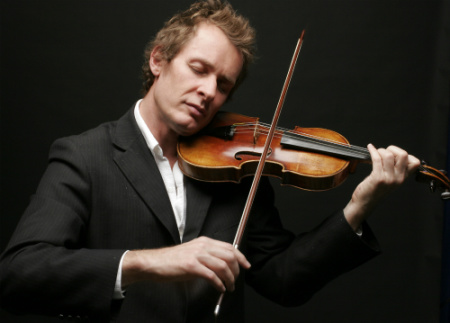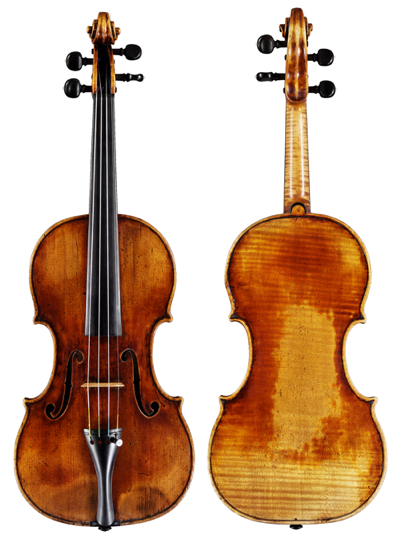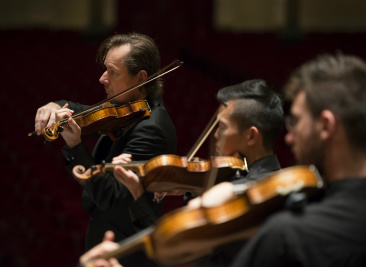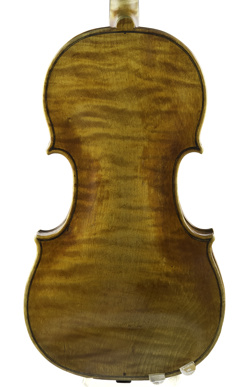It takes a while to get hold of Richard Tognetti. Several weeks in the wilds of Slovenia, curating the Maribor Festival, time away surfing and countless interviews since his return home to Sydney mean it feels more like chasing a rock star than a classical musician. That’s not to mention the $15 million ‘Carrodus’ Guarneri ‘del Gesù’ violin that follows him wherever he goes (except on to the surfboard). That’s as far as the similarity goes, though; once he is on the phone and discussing things that matter to him he is fully engaged, serious and humorous in equal measure.

Richard Tognetti has played the ‘Carrodus’ since 2007, describing its sound as ‘beautiful, deep and mysterious’. Photo: Paul Henderson-Kelly
The ‘Carrodus’ of 1743 belonged to the 18th-century English violinist John Carrodus, although its most interesting origins are in the tree from which its wood came. A dendrochronological test has showed that it’s the same as used for the Paganini ‘Cannon’ ‘del Gesù’ of the same year, and legend has it that Paganini owned both violins, although no evidence has been found to connect him with the ‘Carrodus’. Tognetti has described its sound as ‘beautiful, deep and mysterious,’ with a lack of temperamentality that is fortunate for an instrument that now spends the majority of its time in Australia (Tognetti is leader and Artistic Director of the Australian Chamber Orchestra).
Tognetti uses gut strings on the instrument to maintain as much of its original sound as he can. When it comes to playing Vivaldi’s Four Seasons, which he recently recorded with the Australian Chamber Orchestra, the fact that his instrument was made just 20 years after the piece was written led him further down the road of historically informed performance than he had previously been wont to travel.
‘I was thinking how to use so-called original instruments, and was thinking about the continuo,’ he says. ‘And we had this idea to collaborate with an oud player.’ His contention is that the sights, sounds and smells of Venice are in the DNA of Vivaldi, and this is the driving force behind his performances. The composer would simply have gone out on to the streets of Venice and seen, heard and smelled it all, and, consciously or unconsciously, been absorbing those influences that so ignite Tognetti’s imagination when performing this music.

The 1743 ‘Carrodus’ was bought by a private benefactor for Tognetti in 2007, its $10 million price tag causing some outrage
Over the course of our conversation Tognetti frequently refers to the need for innovation as the foundation to any project. Here, as always, he occupies his position with integrity, although when we talk about the ‘Carrodus’ he is far less populist about the validity of modern instruments than he is about modern music.
‘Look,’ he says. ‘You can’t prove authenticity. The instruments can prove themselves empirically, though, and I have yet to meet a luthier either audacious or genius enough to make an instrument on their own without basing it on Amati, Stradivari or “del Gesù”.’
When an anonymous Australian donor bought the ‘Carrodus’ for Tognetti in 2007, it caused a heated discussion in the press over whether an instrument could be worth so much. ‘But so far, the most expensive instruments are the best,’ says Tognetti. ‘I have played these instruments and if I thought others, or modern copies, were better, I’d happily play them and keep the money to spend on performance.’
And enrich the careers of those violin makers, who are the artists of the present…?
‘Exactly, correct. But all violin makers – and I’ve got quite a few that are close friends – are in awe of the makers they copy. So when I turn up with the “del Gesù”, they salivate! They can’t quite believe they’ve got the “Carrodus” in the room, and none of them would say their instrument was any better.’
So does that mean the ‘Carrodus’ is the easiest violin he has ever played?
‘Interestingly,’ he says, without answering directly, ‘people say you can really press into a “del Gesù”, but from my experience that’s not the case. It starts pushing back and making really strange sounds. But I really love those sounds, which is why I’m into early instruments.’
I ask whether he identifies with a particular maker, or whether his choice of the ‘Carrodus’ was particular to the sound, rather than the maker.
‘I don’t really believe in that,’ says Tognetti. ‘But it’s an interesting question. With the “Carrodus” it’s the depth and graininess I’m really attracted to. But you can also find that in Stradivarius. I’m not a massive fan of that sheen that can come with certain types of Strad, though – I’m much more into gut, and the sound that Anner Bylsma makes, so I’m more attracted to the “del Gesù” sort of sound.
‘It’s interesting with “del Gesù”,’ he continues. ‘Each one is so different. They burp much more easily than other instruments. And scratch. Some people can’t stand them – my dear friend Ivry Gitlis tried to play a “del Gesù” and it just didn’t work at all.’
Australian Chamber Orchestra Instrument Fund
The ACO Instrument Fund came about as a result of concerns among the members of the board of the ACO about what Jessica Block calls ‘the thorny issue of fine instruments that are played in the orchestra but owned by other people.’
Block is the founder and one of the directors of the instrument fund, as well as being deputy general manager of the ACO. Investors (described by Block as ‘sophisticated’, by which she means able to invest at a minimum level of $50,000) buy into instruments by way of ‘units’, with a commitment that is expected to be for ten years, but with an option to apply to redeem those units every three years. So far no one bar one investor has chosen to pull out of what is as safe an investment as is possible in the current market.
‘We did a lot of research when we set up this fund,’ says Block, ‘and when you look at the data, other fine asset classes still rise and fall significantly with changes in the stock market. So around the time of the GFC you saw a real dip in the classic cars, to fine wine, to fine art markets, but the value of fine instruments just steadily holds its own with a very low correlation to those rises and falls.’
All in all, the fund is there to make sure the ACO is able to attract the best musicians and inspire them to make the best music they can. The group is made up of the best players from all over the world, the majority of whom have been brought to Australia by the opportunity to play in the group and become a custodian of one of their extraordinary instruments.
‘They make you expect the unexpected,’ says Block. ‘I’ve worked with the orchestra for 12 years and I still can’t get over how moving that is.’
The fund’s first acquisition was a 1728/29 Stradivari violin in 2011. Its latest is a 1714 violin by Guarneri ‘filius Andreae’ acquired in 2013. Find out more about the fund.
Instruments of the Australian Chamber Orchestra
Besides the two instruments owned by the ACO Fund, the orchestra has amassed a set of instruments loaned by private benefactors.

Tognetti and fellow ACO members. Photo: Simon Van Boxtel
– Giuseppe Guarneri ‘del Gesù’, Cremona, 1743, the ‘Carrodus’, on loan from a private Australian benefactor Cozio ID 40447
– violin by Antonio Stradivari, Cremona, 1728/29, on loan from the ACO Fund Cozio ID 50745
– violin by Giuseppe Guarneri ‘filius Andreae’, Cremona, 1714, the ‘Menges’ (collaboration with Guarneri ‘del Gesù’), on loan from the ACO Fund Cozio ID 44788
– violin by Giovanni Battista Guadagnini, Parma, 1759, on loan from the Commonwealth Bank Group (previously played by Tognetti) Cozio ID 42320
– viola by Giovanni Paolo Maggini, Brescia, 1610, on loan from an anonymous benefactor Cozio ID 44810
– cello by Giuseppe Guarneri ‘filius Andreae’, Cremona, 1729 (collaboration with Guarneri ‘del Gesù’), on loan from Peter Weiss Cozio ID 43989
– cello by Giuseppe Guarneri ‘filius Andreae’, Cremona, 1721, on loan from the Australia Council Cozio ID 40153
– double bass by Gasparo ‘da Salò’, Brescia, late 16th century, on loan from a private Australian benefactor Cozio ID 75248
Caroline Gill is a classical music journalist for publications including Gramophone and The Strad magazines, and a regular critic for BBC Radio 3.
All photographs courtesy of the Australian Chamber Orchestra.
